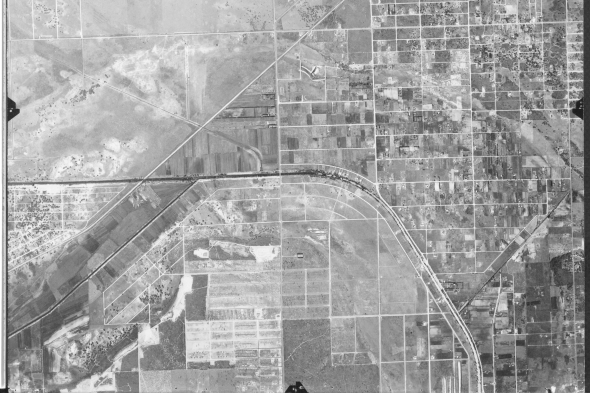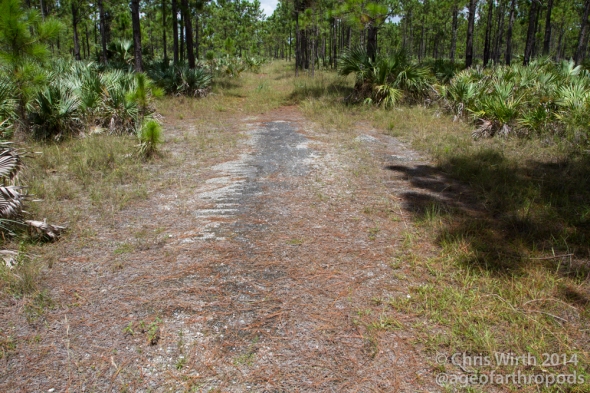The Miami tiger beetle receives “Endangered” status

The Miami tiger beetle, Cicindelidia floridana, and its story are unique. An 18-year-old student first collected the species in 1934 from pine rockland habitat in northern Miami-Dade. Pine rocklands were once the dominant habitat in south Florida, extending from the Florida Keys to the northern border of Miami-Dade County, but development has steadily engulfed this habitat. Today 1.8% of the metro Miami-Dade pine rocklands remain standing.
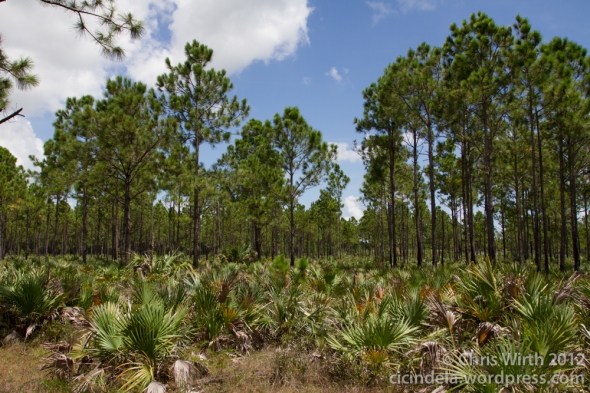
In the context of this widespread habitat loss and seventy years without any beetles observed the Miami tiger beetle was presumed extinct. But, in 2007 a population of Miami tiger beetles was rediscovered in the Richmond Heights pine rocklands, the largest contiguous remaining rocklands in Miami-Dade (below), and in 2015 a second population was found at an undisclosed patch of pine rocklands nearby.
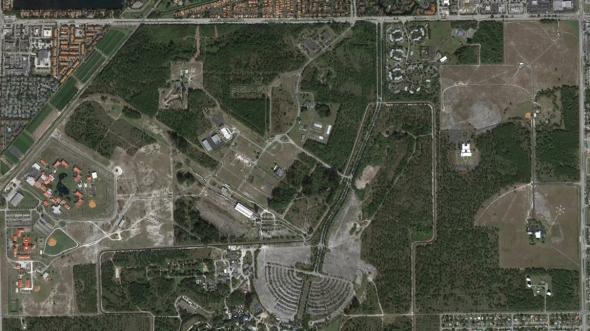
The Miami tiger beetle faces the immediate threats of habitat loss, degradation, and fragmentation from inadequate habitat management and two proposed developments; a mixed-use development, Coral Reef Commons (below) and a major theme park, Miami Wilds.
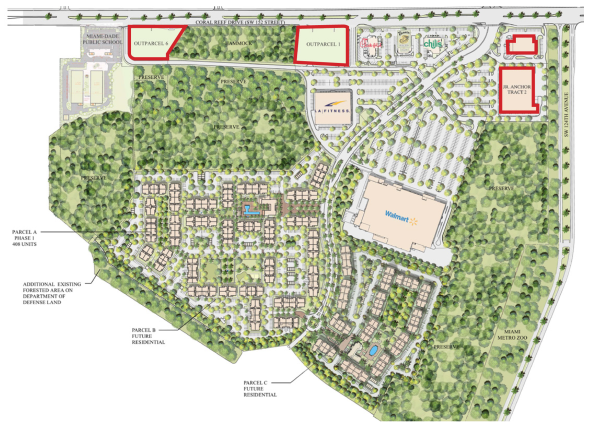
Distressingly, the species is also actively sought by private, non-scientist tiger beetle collectors due to its extreme rarity.
On December 11th 2014, the Center for Biological Diversity, Miami Blue Chapter of the North American Butterfly Association, South Florida Wildlands Association, Tropical Audubon Society, Sandy Koi, Al Sunshine, and I submitted a petition to U.S. Fish and Wildlife Service, urging the Miami tiger beetle be formally listed under the Endangered Species Act.
Today, on October 4th 2016, the Service announced the Miami Tiger Beetle will receive “endangered” status under the Endangered Species Act which will become effective on November 4th 2016.
The Miami tiger beetle joins other Federally listed (threatened and endangered) pine rockland endemics, including the Florida Bonneted bat (Eumops floridanus), Florida leafwing (Anaea troglodyta floridalis), Bartram’s hairstreak (Strymon acis bartrami), Blodgett’s silverbush (Argythamnia blodgettii), Florida brickell-bush (Brickellia mosieri), Big Pine partridge pea (Chamaecrista lineata var. keyensis), deltoid spurge (Chamaesyce deltoidea deltoidea), wedge spurge (Chamaesyce deltoidea serpyllum), Carter’s small-flowered flax (Linum carteri carteri), sand flax (Linum arenicola), and tiny polygala (Polygala smallii).
This species also joins other listed members of the Cicindelinae; there are two endangered tiger beetle species (Cicindela ohlone and Ellipsoptera nevadica lincolniana) and two threatened species (Ellipsoptera puritana and Habroscelimorpha dorsalis dorsalis).
However, no critical habitat has been proposed or designated at this time:
While the designation of critical habitat is prudent, the Service is delaying a proposed designation at this time and expects to complete work on it by September 30, 2017. In addition, there is a proposal to build two developments in the Richmond Pine Rocklands and the Service continues to work with developers.
It would appear that the interests of a few private individuals at Ram Realty and Miami Wilds LLC are taking precedence to the survival of the Miami tiger beetle, its fellow pine rockland endemic species, and the last 1.8% of the metro Miami-Dade pine rocklands. The publicly available plans released by the Coral Reef Commons and Miami Wilds developers show that un-surveyed pine rocklands and Miami-tiger-beetle occupied habitat, respectively, will be paved over and the stifling development will severely limit any management of the remaining habitat, chiefly by preventing controlled burns which pine rocklands and their inhabitants depend upon.
Despite this shortcomings, I sincerely thank the staff members of the South Florida Ecological Service. I’d also like recognize the efforts of my fellow Petitioners and extend my thanks.
Please stay tuned to this blog for updates on the Miami tiger beetle and its habitat.

References
Bousquet, Y. 2012. Catalogue of Geadephaga (Coleoptera, Adephaga) of America, north of Mexico. ZooKeys 245:1-1722.
Brzoska, D., C.B. Knisley, and J. Slotten. 2011. Rediscovery of Cicindela scabrosa floridana Cartwright (Coleoptera: Cicindelidae) and its elevation to species level. Insecta Mundi 0162:1-7.
Cartwright, O.L. 1939. Eleven new American Coleoptera (Scarabidae, Cicindelidae). Annals of the Entomological Society of America 32:353-364.
Center for Biological Diversity. 2016. Four Florida Plants Protected Under Endangered Species Act. Press Release. September 28, 2016
Florida Natural Areas Inventory (FNAI). 2010. Pine Rockland, in Guide to the natural communities of Florida: 2010 edition. Florida Natural Areas Inventory, Tallahassee, FL. 8 pp.
Knisley, C.B. 2008. Current status of the “Miami” tiger beetle. Final Report. October 28, 2008.
Knisley, C.B. 2011. Taxonomy, biology, and conservation of the Florida tiger beetle. Final Report to South Florida Ecological Services Office. February 20, 2011.
Knisley, C.B. 2013. Biological studies of the Florida tiger beetle, 2011-2013. Final Report. April 13, 2013.
Knisley, C.B. 2015. Species assessment of the Miami tiger beetle, Cicindelidia floridana. Revised Report. June 6, 2015.
Knisley, C., M. Kippenhan, and D. Brzoska. 2014. Conservation status of United States tiger beetles. Terrestrial Arthropod Reviews. 7: 93-145.
Natureserve 2016. NatureServe Explorer: An online encyclopedia of life. Version 7.0.
Pearson, D.L., C.B. Knisley, and C.J. Kazilek. 2006. A field guide to the tiger beetles of the United States and Canada: Identification, natural history and distribution of the Cicindelinae. Oxford University Press, New York.
Pearson, D.L., C.B. Knisley, D.P. Duran, and C.J. Kazilek. 2015. A field guide to the tiger beetles of the United States and Canada: Identification, natural history and distribution of the Cicindelinae. Second edition. Oxford University Press, New York.
U.S. Fish and Wildlife Service. South Florida Multi-Species Recovery Plan: Appendix C. Species of Concern and their Associated Community Types in South Florida.
URS Corporation, The Institute for Regional Conservation, and Muller and Associates, Inc. 2007. Miami Dade County Environmentally Endangered Lands Program Management Plan, Part II: Management of specific habitat types, Chapter 1: The pine rockland habitat. Submitted to Environmentally Endangered Lands Program, Miami, Florida by URS Corporation. K.A. Bradley, G.D. Gann, M.J. Barry, contributors.
USFWS Miami Tiger Beetle Hearing: Comments
Introduction:
On December 11th 2014, the Center for Biological Diversity, Miami Blue Chapter of the North American Butterfly Association, South Florida Wildlands Association, Tropical Audubon Society, Sandy Koi, Al Sunshine, and I (the Petitioners) submitted a petition to U.S. Fish and Wildlife Service (the Service), urging the Miami tiger beetle (MTB), Cicindelidia floridana, be formally listed under the Endangered Species Act.
A full year and seven days later, on December 18th 2015, the Service proposed “endangered” status for the MTB, and announced a “hearing for members of the general public to comment on that proposal in person,” as required by Section 4(b)(5) of the Endangered Species Act.
This public hearing was held on January 13, 2016 at Miami-Dade College’s Kendall campus and I flew in from Arizona to attend. I’ve already posted a brief synopsis, audio, and photos from the hearing and in this post I’m going to respond to “three” commenters.
USFWS Miami Tiger Beetle Public Hearing
With the December 2015 announcement by the U.S. Fish and Wildlife Service (Service) of proposed “endangered” status for the Miami tiger beetle (Cicindelidia floridana), a “hearing for members of the general public to comment on that proposal in person” was scheduled, as required by Section 4(b)(5) of the Endangered Species Act. This public hearing was held on January 13, 2016 at Miami-Dade College’s Kendall campus and I flew in from Arizona to attend. To listen to audio from the hearing click here or keep reading for my photos and some brief comments.
Shortly after 5pm I made my way across Miami-Dade College’s Kendall campus to their main auditorium. As I approached the auditorium entrance I saw half a dozen law enforcement officers monitoring the proceeding; two officers at a sign-in table next to the entrance, two at table on the opposite side, and, in between, two at the auditorium doors. Even inside the auditorium there was a USFWS Refuge officer at each entrance, further reinforcing the seriousness of this federal hearing.
Even through I was early there were over twenty people already present, both members of the public and Miami-Dade college students. As I waited for the start of the hearing I chatted with the USFWS officials present and picked up copies of their Miami tiger beetle factsheet and FAQ.
Prominently displayed were two posters depicting the historical and current (only 1.8% remains) pine rocklands in Miami-Dade county and the Richmond Heights pine rocklands, the primary habitat for the Miami tiger beetle. At a glance it is clear the drastic, almost complete, loss of pine rocklands within Miami-Dade county:
The hearing began with an informative presentation on the beetle and then the public comment period began. Among those speaking were myself, the lobbyist/head of Miami Wilds LLC, Paul Lambert, concerned citizens, and members of the Miami Pine Rocklands Coalition. I’ve included selected audio from the hearing below:
I will respond to Mr. Lambert/Miami Wild’s concerns and the ecologist’s comments in a second post. Additionally I’ll post my full comments to the Service in a separate post.
Please don’t forget the public comment period on USFWS’s proposal to list the Miami tiger beetle as endangered is still open (until February 22, 2016). To submit a comment to the Service go to the official site and click comment now.

(L-R) Sonya Thompson (Miami-Dade County), Chris Wirth (Cicindela blogger & Miami tiger beetle petitioner), Sandy Koi (Miami tiger beetle petitioner), Belén Valladares (Miami Pine Rocklands Coalition vice-president), Al Sunshine (Miami Pine Rocklands Coalition president & Miami tiger beetle petitioner).
Acknowledgements
I’d like to extend special thanks to Miami Pine Rocklands Coalition Vice-President Belén Valladares for providing transportation and lodging during my trip.
Ram Realty’s Habitat Conservation Plan
Author’s Note: Please excuse this belated and partially off-topic post; I’ve written these comments because I feel it is important to highlight the conduct of Ram Realty and to present the best available facts concerning the potential development of Coral Reef Commons site.
In May 2015 Ram Realty filed a lengthy Habitat Conservation Plan (HCP) with the US Fish & Wildlife Service (USFWS) for the development of Coral Reef Commons (CRC). In a press release Ram claimed the HCP, prepared by Johnson Engineering Inc., is a “science-based document” despite the fact that this document contains grievous misrepresentations of the facts. Below I’ve responded to Ram’s most egregious claims, chiefly the present state of the site and the impacts of the development.
No Take of Listed Species?
In their project overview Ram expresses their intent to secure a 50-year Incidental Take Permit (ITP) while, at the same time, insisting that the CRC development:
[W]ould not result in a take [death] of listed species, nor … adversely impact listed species. (Ram 1-2)
This “no take” scenario is absolutely impossible; almost half (48%) of the site is globally imperiled pine rocklands and a majority of the property is USFWS designated critical habitat for four endangered species. Despite their protestations to the contrary Ram’s HCP explicitly calls for the destruction of endangered plants and the host plant for two endangered butterflies.
One Year and Seven Days
On December 18th 2015, over a full year and seven days after a listing petition to protect the Miami tiger beetle (Cicindela floridana) was filed by the Center for Biological Diversity, advocacy groups, and several individuals (including myself),the U.S. Fish and Wildlife Service announced their proposal for the listing of the Miami tiger beetle as endangered.
In a press release Jaclyn Lopez, Florida director at the Center for Biological Diversity said:
Watching the Miami tiger beetle forage, with its shiny, iridescent body and lightning-quick legs, is mesmerizing. Endangered Species Act protection will help ensure the beetle’s rare pine rockland hunting grounds remain intact in the face of ever-pressing development.
The USFWS proposed listing could have significant impacts on the potential developments in the Richmond Heights pine rocklands, home of this beetle.
With the USFWS’s announcement a public comment period is open until February 22 and a public hearing is scheduled on January 13th at Miami-Dade College, Kendall Campus.
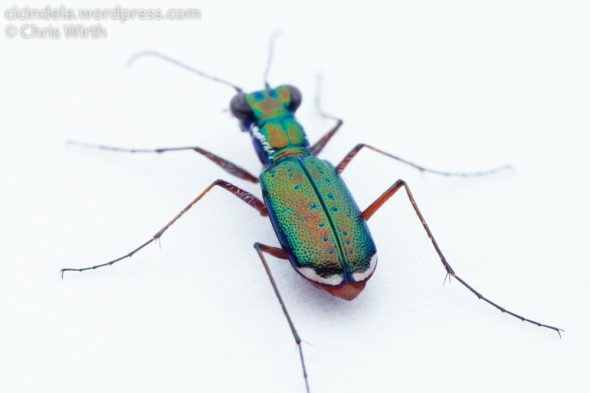
A Second Miami Tiger Beetle Population Discovered
Note: This post was largely written in August, however I held off publishing due to the sensitive nature of this discovery. This Friday the U.S. Fish and Wildlife Service proposed listing the Miami tiger beetle as an endangered species and announced the existence of a second population of the MTB. With this official confirmation I’m publishing this post in hopes of contributing some context and further information about this population.
The story of the Miami tiger beetle, Cicindela floridana, a beautifully iridescent tiger beetle presumed extinct but rediscovered in 2007 is unique. This fiercely predatory beetle is a south Florida endemic only known from pine rocklands, a habitat once common in Miami-Dade county but, due to extensive development, today only 1.8% of the metro Miami-Dade rocklands remain.
The entomologist Frank N. Young Jr., an 18 year old student at the time, discovered the Miami tiger beetle from pine rocklands in 1934 at a site in northern Miami-Dade county. However, by 1947 this habitat was lost to development as the native pine rocklands were transformed into the neighborhoods of north Miami and Miami Shores (below).
In 2007, after a 73 year absence and presumed extinction, the Miami tiger beetle was rediscovered near Zoo Miami in pine rocklands. This site is part of the Richmond Heights pine rocklands, the largest contiguous remaining areas of this habitat in metro Miami-Dade. Spurred by this rediscovery entomologists surveyed pine rocklands throughout southern Florida in search of the Miami tiger beetle.
Extensive surveys were conducted in both scrub habitats and most of the pine rockland sites in Miami-Dade, Ft. Lauderdale and Palm Beach Counties (Knisley, 2008). Most were unsuitable probably because they were too densely vegetated or the substrates were mostly oolitic limestone rock with few or no sand patches (Knisley et al. 2014).
Despite these efforts in the years since its remarkable rediscovery the Miami tiger beetle had only been found at a handful of directly adjacent sites in the Richmond Heights pine rocklands. Even the known population is few in number (under a hundred adult beetles observed) and face further threats of vegetation encroachment and potential habitat development (see here for more).
This changed in July when Jimmy Lange, a field botanist at Fairchild Tropical Botanic Garden, and Alyssa Dawson, an intern from Ohio University, were surveying an undisclosed patch of pine rocklands for rare plants (namely Brickellia mosieri, an endangered species) when, as Lange describes it, “[i]n my meanderings I was [documenting] other rare species as I encountered them … when I bumped into a tiger beetle.” But this was not just any tiger beetle, Lange and Dawson found three Miami tiger beetles (Cicindela floridana).
Lange and Dawson’s discovery offers a small boost to the hopes for the survival of the Miami tiger beetle. But even with the discovery of the second population the MTB is still in danger. The MTB habitat, pine rockland, has been extensively developed and today only 1.8% of the metro Miami-Dade pine rocklands remain. These habitats are also under the constant threat of vegetation encroachment primarily due to the lack of controlled burns (which pine rocklands depend upon).
A major question regarding this second population of MTBs is whether the discovery of new populations would alter the expert’s rating of the species as seriously imperiled and recommendation for formal protections (Knisley et al. 2014). In brief this second population does not significantly alter the Miami tiger beetle’s current standing. First, this “population” is represented by three observed beetles and thus likely does not provide a sufficient number of individuals to contribute to the species survival. Second, Knisley et al. (2014) account for the existence of other populations in their recommendation methods:
Examples of our grading system are as follows: A 1 would be comparable to the NatureServe grade of 1, usually with five or fewer known populations and significant threats; a 1+ would be at the upper range of these factors and 1- at the lower range.
For the 1 +/- grade given by Knisley a species must face significant threats which is absolutely the case for the MTB. Most significantly both populations face the “loss, degradation, and fragmentation” (USFWS) of habitat, primarily from the constant encroachment of vegetation, both ecological succession due the lack of fires and invasive species.
Of particular note the U.S. Fish and Wildlife Service did not release the location of this new population due to the threat of collection:
Tiger beetles are in high demand and avidly collected. We are aware of internet advertisements for the sale and trade of other florida tiger beetles.

Once altered = gone forever?
With efforts to develop globally imperiled pine rocklands met with a public outcry, Ram Realty, developers of the planned Coral Reef Commons, have attempted to portray the Coral Reef Commons (CRC) pine rocklands as largely developed. While this is not true (only 12% of the CRC site is significantly developed), what happens when pine rocklands are altered? Is the site really no longer a place worth preserving as Ram suggests?

In the image above is one of the best maintained Richmond Heights pine rockland tracts, covering over 60 acres. Today it sits just outside of Zoo Miami (and in the footprint of Miami Wilds!) but in the 1940’s it was the site of Richmond Naval Air Station. Below in an image form 1952 you can see the expansive footprint of Richmond NAS.
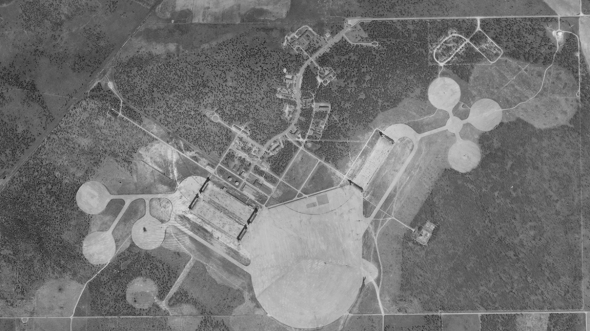
In this side-by-side view you can see the remnants of the blimp mooring pads and the red outline of this 60+ acre tract of rocklands in 1952 and in 2014. What today is a beautiful forest was tarmac, bare earth, and grass back in the 1950s. This land was originally pine rocklands but was cleared (in the early 1940s) to make way for the naval air station. But with the decommissioning of the Richmond NAS and subsequent period of unhindered growth (and semi-regular wildfires/prescribed burns) it is again beautiful pine rocklands. Most importantly this site is home of the rare Miami tiger beetle, a candidate for state and federal protection, along with numerous other endemic and rare animal and plants.
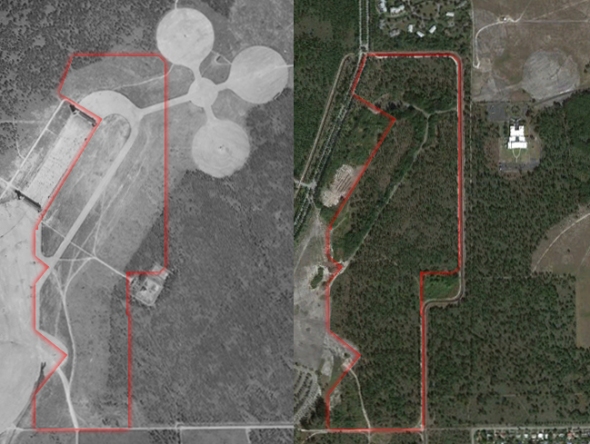
As you can see even pine rockland tracts which have been altered are excellent candidates for restoration and seriously in need of protection. This need is even more urgent for the remaining intact Richmond Heights pine rocklands, which sit in the footprints of Coral Reef Commons and Miami Wilds. Ram Realty and 20th Century Fox developers are still pushing forward on their Coral Reef Commons and Miami Wilds, respectively, and Miami-Dade county is trying to circumvent any environmental regulations protecting or pertaining to these pine rocklands by attempting to declare a massive swath of land around Zoo Miami as a “slum or blighted area.” These developments are both environmentally unacceptable and poorly planned, with no adequate measures taken to address the pine rocklands.
Blight?
[The Committee] accepts the Study identifying approximately 2,146 acres within the unincorporated municipal service area (UMSA), which lie entirely in Commission District 9 represented by Commissioner Dennis C. Moss, to be slum and blighted.
Miami-Dade Legislative Item 142509
This month a Miami-Dade county committee approved a resolution from county commissioner Dennis Moss to designate the Richmond Heights pine rocklands (the largest fragement of pine rocklands outside the Everglades National Park and the only habitat of the Miami tiger beetle) along with the surrounding lands “a slum or blighted area.” This resolution stemmed from a county-commitioned study supplied by the firm Calvin, Giordano & Associates which built a tenuous case that slum or blight conditions exist in and around the Richmond Heights pine rocklands. The Committee forwarded the resolution to the full Board of County Commissioners for consideration:
It is recommended that the Board of County Commissioners … consider taking the following actions:
4. The Board declares and finds that there is a need for a community redevelopment agency to function and carry out the community redevelopment purposes of the Act; and
5. The Board directs the County Mayor or the County Mayor’s designee to prepare a plan of redevelopment for the Area, and to submit the plan of redevelopment to the Board for approval after notice and public hearing.
Should a community redevelopment agency be created, the Area covered will make it the second largest in the County, with only the North Miami Community Redevelopment Agency larger at 3,540 acres. The Study includes the Zoo Miami, Coast Guard, and the former University of Miami properties.
Miami-Dade Legislative Item 142509
The goal in establishing the existence of slum or blight conditions and subsequent community redevelopment agency (CRA) is to create a special tax district¹ which will channel public funds into development of the site. The development in question is the $930 million theme park, Miami Wilds. As I have written previously the construction of this theme park (in its present incarnation) is a serious and unacceptable threat to the Richmond Heights pine rocklands and the survival of numerous endangered species, including the Miami tiger beetle, a candidate for emergency state and federal protection.
The developers, Miami Wilds LLC, have already received approval for an initial $13.5 million in bond funds to replicate the US Coast Guard communications tower array which currently stands in the footprint of the theme park. However, use of this land requires Federal permission and approval of the developer’s plans; approval which has not yet been given.
The Richmond Heights pine rocklands have survived comparatively unscathed since the since the early development of the site in the 1940s and these lands represent a major portion of the 1.8% of pine rocklands left outside the Everglades National Park. Any further development seriously jeopardizes the rocklands, chiefly by fragmenting the remaining habitat and stifling fires, a necessary ecological cycle for the continued health of the habitats.
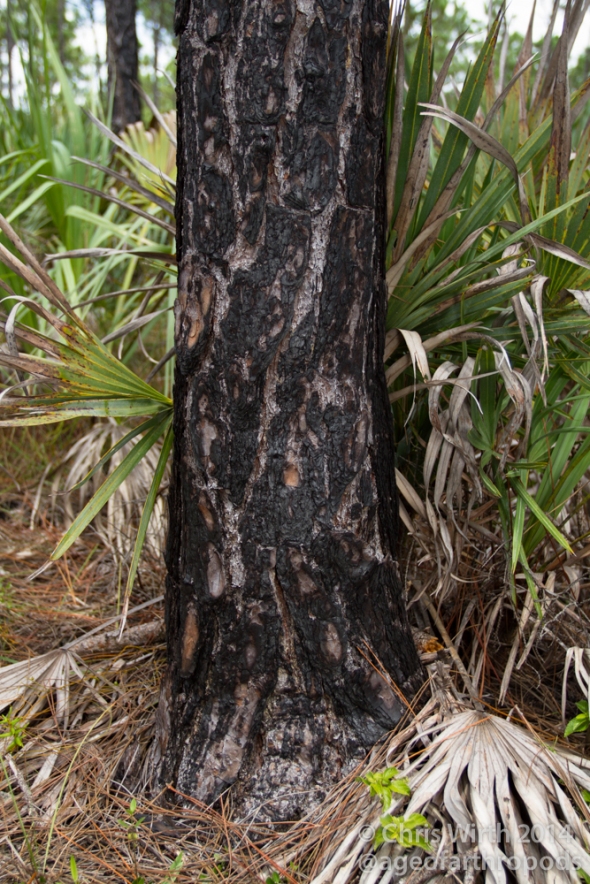
Proper management of pine rockland fragments includes prescribed burning (which can generate heavy amounts of smoke)… Construction of hospitals, schools, apartments, and hotels around [rocklands] should be discouraged because of conflicts with smoke generation during prescribed fires. URS Corporation et al 2007
These current plans for Miami Wilds and Coral Reef Commons will severely fragment the remaining Richmond Heights pine rocklands. Once these rocklands are surrounded by heavy development any prescribed burning will be extraordinarily unlikely.
… maximize open space and limit pollution runoff [around rocklands]. URS Corporation et al 2007
A secondary impact of any development is that without sufficient buffer areas around the rocklands the new fragments will be highly susceptible to pollution and encroachment of non-native and invasive animals and plants from the surrounding.
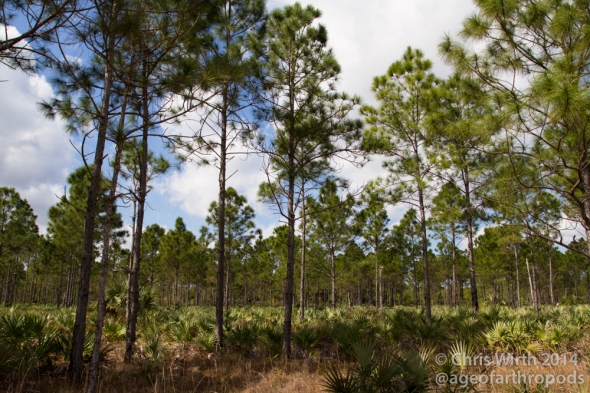
The current plans for development do not adequately conserve these imperiled rocklands and are not a reasonable option for the continued survival of this unique habitat and its inhabitants. Over 98% of the Miami-Dade rocklands have been lost to development. There are better options for utilization of the non-rockland areas, options which do not fragment or destroy rocklands, alternatives which provide adequate buffers to facilitate the necessary management of the habitat.
The “blight” resolution has been forwarded to the Board of County Commissioners for consideration and a full public hearing on January 21st.
Local residents are planning a rally for the rocklands on January 17th
The Center for Biological Diversity has a letter to the Miami Board of County Commissioners which you can sign and send in support of preserving the pine rocklands.
View the resolution here. Read the Calvin, Giordano & Associates study here.
Also see the Miami Herald article on the this latest development.
Notes
¹In designating an area as a CRA governing bodies are afforded the opportunity to leverage public financing for the purpose of land acquisition, demolition, housing and infrastructure improvements, environmental remediation, neighborhood enhancement and other similar activities. This is accomplished through a funding mechanism known as Tax Increment Financing (TIF). From MetroZoo Finding of Necessity Study 2014 Update
References
URS Corporation, The Institute for Regional Conservation, and Muller and Associates, Inc. 2007. Miami Dade County Environmentally Endangered Lands Program Management Plan, Part II: Management of specific habitat types, Chapter 1: The pine rockland habitat. Submitted to Environmentally Endangered Lands Program, Miami, Florida by URS Corporation. K.A. Bradley, G.D. Gann, M.J. Barry, contributors.
Emergency protection sought for Miami tiger beetle
Today the Center for Biological Diversity filed emergency petitions to protect the exceedingly rare Miami tiger beetle, Cicindela floridana, a South Florida pine rocklands endemic, as a protected species under Florida law and as endangered under the federal Endangered Species Act.

Pine rocklands once stretched from the Florida Keys up to the northern edge of Miami-Dade County, but widespread urbanization and agricultural development destroyed the majority of Floridian pine rockland. This fire-dependent community, found on limestone outcroppings, is comprised of a sparse canopy dominated by Florida slash pine, Pinus elliotti var. densa, and a varied understory. Today, only a fraction of the original Miami pine rockland habitat remains; by some estimates as little as 1.8%. Moreover, most of these remaining areas are quite small and often widely separated by miles of heavy development.
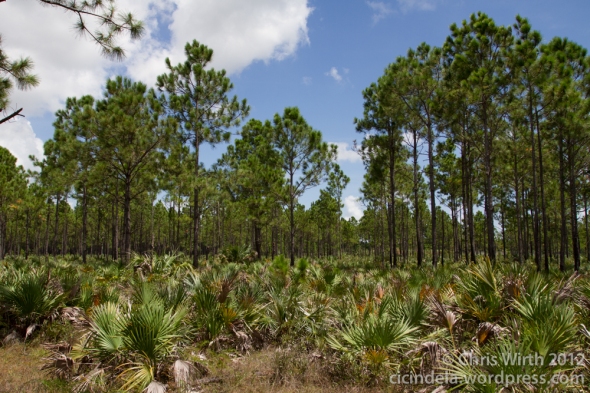
The pine rockland habitats are home to many endemic species, many of which are listed as endangered including the Florida Bonneted bat (Eumops floridanus), Bartram’s hairstreak (Strymon acis bartrami), Florida leafwing (Anaea troglodyta floridalis), Florida brickell-bush (Brickellia mosieri), deltoid spurge (Chamaesyce deltoidea deltoidea), Carter’s small-flowered flax (Linum carteri carteri), tiny polygala (Polygala smallii).
Today many of these remaining pine rocklands and their inhabitants now face another danger; due to the lack of fire, both native and non-native vegetation are taking over the habitats which incrementally transitioning to hardwood hammocks.
Of greatest concern is the Richmond Heights pine rocklands, where the Miami tiger beetle was rediscovered in 2007. In addition to vegetation encroachment, there are plans to develop significant portions of the pinelands. The first, and most immediate, is Ram Realty’s plan to develop and 88-acre parcel of rocklands purchased from the University of Miami.
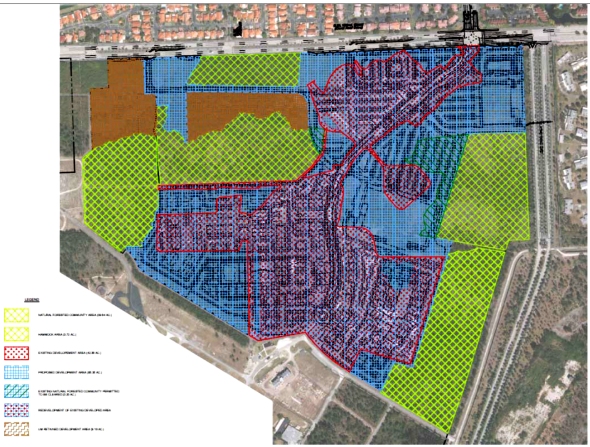
While Ram has set aside some of the land for nature preserves, any development seriously jeopardizes the rocklands by fragmenting the remaining habitat and stifling fires, a necessity for the continued health of the habitats. The second, and most expansive in scope, is the county’s plan to develop a major amusement park in and around the rocklands.
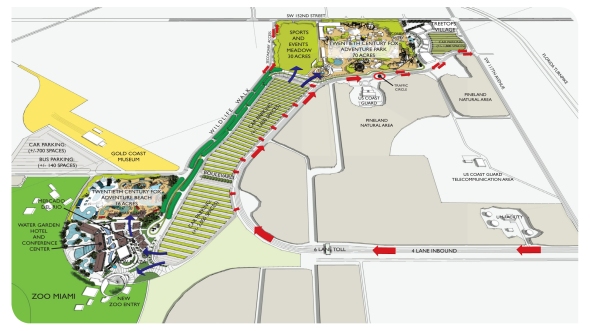
This plan calls for major development including a four lane highway and major transportation corridor through the rocklands. This development will irrevocably damage all of the Richmond pine rocklands, through fragmentation, pollution, and stifling fires within the remaining habitat.
Both development pose real and immediate risks to endangered and rare species, including the Miami tiger beetle. These developments will results in the destruction and degradation of pine rocklands and will kill endangered and candidate species including the adults and larvae of the Miami tiger beetle.
Even before the current plans for development the Miami tiger beetle (Cicindela floridana) was a U.S. Fish and Wildlife Service species of concern. Additionally, Knisley et al (2014) assigned the Miami tiger beetle a 1+ grade, their “highest level of rarity and/or threats” in a comprehensive review of the conservation status of United States tiger beetles. With over 98% of the potential former habitat gone and direct threats to the only remaining habitat this species is in need of urgent action to prevent its extinction.
The Center for Biological Diversity’s press release is available at their website.
References
Knisley, C., M. Kippenhan, and D. Brzoska. 2014. Conservation status of United States tiger beetles. Terrestrial Arthropod Reviews. 7: 93-145.
U.S. Fish and Wildlife Service. South Florida Multi-Species Recovery Plan: Appendix C. Species of Concern and their Associated Community Types in South Florida.
URS Corporation, The Institute for Regional Conservation, and Muller and Associates, Inc. 2007. Miami Dade County Environmentally Endangered Lands Program Management Plan, Part II: Management of specific habitat types, Chapter 1: The pine rockland habitat. Submitted to Environmentally Endangered Lands Program, Miami, Florida by URS Corporation. K.A. Bradley, G.D. Gann, M.J. Barry, contributors.
Presumed extinct, Floridian tiger beetle rediscovered after 73 years
It is about five in the morning on a warm August day and I am sitting in the Richmond International airport. I am waiting to board a flight to Miami, Florida where I will be meeting up with Dr. Barry Knisley, researcher and authority on tiger beetles.
Florida is home to many species of tiger beetles including several endemic to the state. However, the habitats of a number of species are today threatened by urbanization or the development of land for agricultural use, particularly for Florida’s ubiquitous citrus crops. One of these endemic tiger beetles is the strikingly green-colored floridana form of the minute species Cicindela scabrosa.
This form was first collected in August of 1934 by Frank N. Young and formally described five years later by O.L. Cartwright as a subspecies of Cicindela abdominalis. Cartwright’s description was composed of two brief sentences in the June 1939 Annals of the Entomological Society of America:
Differs from abdominalis in the shinning green color of head, thorax and elytra, the later with purplish reflections posteriorly at the sides, and in the strong deep punctures and fovea of the elytra. The green color will also separate this variety from the variety scabrosa Schaupp.
Additionally, Cartwright notes that Young collected 21 specimens which were divided between museums and private collections:
Holotype and 20 paratypes collected at Miami, Florida, August 9-12, 1934, by Frank Young. Holotype deposited in the U.S. National Museum, paratypes in the collections of California Academy of Science, Museum of Comparative Zoology at Harvard, and in the private collections of F. N. Young, W. M. Gordon, M. A. Cazier, J. W. Angell and the author.
 One of the USNM paratypes
One of the USNM paratypes
Cicindela scabrosa var floridana is a member of a complex of closely related, small cicindelids. The archetypal species in this complex, which also includes C. highlandensis, is Cicindela abdominalis. There has long been much confusion over the relation between these species; at one point there were no less than three synonymous species names for both Cicindela abdominalis and C. scabrosa. In his 1984 treatment of the Cicindela abdominalis complex, Choate elevated Cicindela scabrosa to a full species and placed Cicindela abdominalis floridana as a synonymy of Cicindela scabrosa, attributing the green color to be a sign of recent emergence.
Years after his discovery of C. scabrosa var floridana, in communication with fellow entomologists, Young reported that he collected the specimens in the area surrounding Barry College. Unfortunately, this area, like so much of the neighboring region, had been heavily developed in the intervening time. Several researchers, including Knisley, surveyed numerous Miami-Dade county parks and area preserves for C. scabrosa var floridana but without success.
 Approximate view of the original collection site(s) in 1999. Image courtesy of the U.S. Geological Survey
Approximate view of the original collection site(s) in 1999. Image courtesy of the U.S. Geological Survey
In their 2006 field guide to the tiger beetles of North America, Pearson, Knisley, and Kazilek noted:
An isolated population [of C. scabrosa] in the Miami area has been considered as a subspecies, C. scabrosa floridana Cartwright, which is smaller … and distinctly green above. This population … may now be extinct, probably because of habitat destruction and urbanization.
And so with no suitable habitat remaining and no beetles seen since 1934, despite extensive surveys, this form was presumed to be extinct.
But in September of 2007, over 70 years after this species had last been observed in the wild, a population of Cicindela scabrosa var floridana was rediscovered on privately-owned land in the greater Miami area. Jeff Slotten, a lepidopterist, happened across this population while surveying for butterflies and, being familiar with this species, was well aware of the significance of his discovery. He contacted Barry and a fellow tiger beetle enthusiast, David Brzoska; they set about surveying potential habitats and soon found another population at a directly adjacent site.
The area upon which much of present-day Miami sits was once covered by pine rocklands. This fire-dependent community, found on limestone outcroppings, is comprised of a sparse canopy dominated by Florida slash pine, Pinus elliotti var. densa, and a varied understory which includes many endemic plant species. This habitat once stretched from the Florida Keys up to the northern edge of Miami-Dade County, but in the 1940’s the invention and ensuing widespread use of the rock plow marked the destruction of the majority of Floridian pine rockland.
Today, only a fraction of the original Miami pine rockland habitat remains; by some estimates as little as 2%. Moreover, most of these remaining areas are quite small and often widely separated by miles of heavy development. In addition, many of these remaining pine rocklands now face a new danger; due to the lack of fire, they are being overrun by both native and non-native vegetation as the habitats are transitioning to hardwood hammocks.
Shortly after my arrival in Miami, Barry and I are on the road, heading to survey a potential habitat. Unfortunately the most promising area, within a neighborhood park, was an overgrown mess of vines and small hardwood trees. This turns out to be the norm; while we visit several potential habitats, they too are all overgrown. It was evident that vegetation had been growing unchecked for years and no attempt at maintaining these habitats had been made.
We next head to the site where C. scabrosa var floridana was first rediscovered. This area, along with several other parcels of land, is bordered on one side by a highway while a large development wraps around the other sides. Despite this encroachment there remains a sizable area of pine rockland which, thanks to controlled burns, is in exceptional condition.
 An open patch of sand, ideal habitat for C. scabrosa var floridana; notice the charred remnants of a tree on the ground.
An open patch of sand, ideal habitat for C. scabrosa var floridana; notice the charred remnants of a tree on the ground.
Barry and I weave through the clumps of saw palmetto toward a sandy exposure and we pause at the edge. Before long there is a hint of movement and a small tiger beetle darts from the base of a blade of grass towards the center of the sandy patch.
 There’s a beetle here…
There’s a beetle here…
Its coloration is unique; it is dark, not black, but rather a deep iridescent bronzy-green hue. We inspect several other patches and see a fair number of beetles; the temperature is over 90 degrees and the beetles are very active. Most are moving in and out of the sparse patches of shade or sporadically about the sandy areas, occasionally darting after an ant.
 Barry watches a patch of habitat for floridana
Barry watches a patch of habitat for floridana
Trying to photograph one is particularly difficult; not only are the beetles fast and small, but there are also jagged chunks of limestone sticking out of the sandy ground making it difficult to move about. On my hands and knees, I slowly approach a beetle but it flies off. Again I approach a beetle; it also takes flight. At last I come across a more cooperative beetle and manage a couple quick shots before it also darts away.

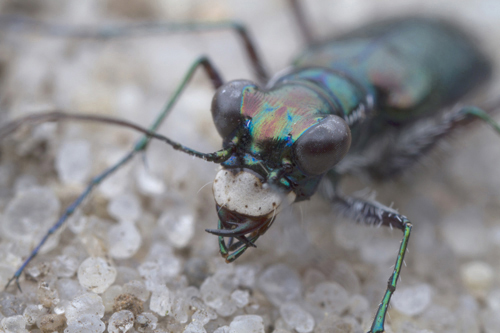 A male C. scabrosa var floridana
A male C. scabrosa var floridana
 A weathered chunk of limestone sticks out of the sand
A weathered chunk of limestone sticks out of the sand
The next day Barry and I set out to survey another promising site; this one borders the area where C. scabrosa var floridana was rediscovered. We do notice some suitable habitat, but most of the ground is covered with a layer of pine needles from the dense canopy. For over an hour there is no trace of the beetles; at last we find a more open area near the edge of the trees.As we walk through the low vegetation, first Barry and then I see a flash of movement, as if a tiger beetle were taking flight. However, neither of us get a good look and only when we spot a stationary beetle are we sure of what we saw. After this exciting find we drive to the second site where floridana was rediscovered. This property sits next to the first site and has also been maintained by controlled burning.
But, on the portion of this property bordering the development, there is a considerable amount of encroaching vegetation which threatens to choke out any exposed sandy areas. The last time it was burned was clearly several years prior to our survey and, as one might suspect, we found no beetles in this area. Moving on, Barry and I find a larger patch of habitat and soon catch sight of more beetles. Here the ground is quite rocky and the saw palmettos are tightly packed, so I am unable to get a decent chance to photograph the beetles in their habitat. I settle instead for a few shots of some beetles which Barry nets as we continue the survey.
 Slowly moving in towards a beetle
Slowly moving in towards a beetle
 Barry carefully holds a female during the survey
Barry carefully holds a female during the survey
 This form is small, with a body length under 1cm.
This form is small, with a body length under 1cm.
As it comes closer to mid-afternoon we wrap up the survey and I begin to prepare for my return; though very short, this trip has been particularly productive. My flight leaves Miami International as the sun sets, my goal reached – I have the pictures I hoped for.
Over the past couple of years, Barry has worked along with Brzoska and Slotten in examining several differences between this form and the closely related members of the C. abdominalis complex. Based on morphological, seasonal, and distributional differences, C. scabrosa var floridana has been elevated to a full species, Cicindela floridana, in a soon to be published paper.
 A side-by-side comparison of the four species of the C. abdominalis complex (L-R): C. floridana, C. scabrosa, C. abdominalis, C. highlandensis.
A side-by-side comparison of the four species of the C. abdominalis complex (L-R): C. floridana, C. scabrosa, C. abdominalis, C. highlandensis.
 A captive C. floridana showing the vivid green color, reduced maculations, and bright red abdomen.
A captive C. floridana showing the vivid green color, reduced maculations, and bright red abdomen.
While the populations appear to be stable, this species requires more research and management; particularly, the remaining habitats must be sufficiently maintained. Controlled burns should be regularly conducted, as they are the first and most critical steps toward control of the encroaching vegetation. With proper care and protection this species, can come to thrive again.
Acknowledgments:
Special thanks to Barry Knisley for facilitating my trip to Florida and providing the specimens for the captive and comparative photograph. Also thanks to Art Evans for assistance in accessing the USNM collection.
References:
Cartwright, O.L. 1939. Eleven new American Coleoptera (Scarabidae, Cicindelidae). Annals of the Entomological Society of America 32:353-364.
Choate, P.M. 1984. A new species of Cicindela Linnaeus (Coleoptera: Cicindelidae) from Florida, and elevation of C. abdominalis scabrosa Schaupp to species level. Entomological News 95: 73-82.
Pearson, D.L., Knisley, C.B., Kazilek, C.J. 2006. A field guide to the tiger beetles of the United States and Canada. Oxford University Press, New York 8 + 227pp.
U.S. Fish and Wildlife Service. Multi-Species Recovery Plan for South Florida: Pine Rocklands. www.fws.gov/southeast/vbpdfs/commun/pr.pdf
















